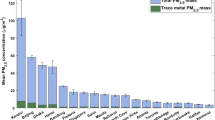Abstract
Since 1992, the International Atomic Energy Agency (IAEA) has been promoting studies of air pollution using a standard design of air sampler that provides separation on filters into two size fractions with cutoffs of 2.5 and 10 Μm (approximately). These are the size ranges presently considered to have the most important health consequences. Such filter samples are highly amenable to analysis using nuclear and related techniques. After reviewing some of the health effects of airborne particulate matter and current air quality standards and guidelines, this article provides an overview of current and recent IAEA programs in this area, which involve collaborative activities with participants in more than 40 countries.
Similar content being viewed by others
References
The Economist, pp. 89–91, 17 September 1994.
J. Schwartz, Air pollution and daily mortality: a review and meta analysis,Environ. Res. 64, 36–52 (1994).
D. W. Dockerty, C. A. Pope, X. Xu, J. D. Spengler, J. H. Ware, M. E. Fay, et al., An association between air pollution and mortality in six U.S. cities,New Engl. J. Med. 329, 1753–1759 (1993).
United States Environmental Protection Agency, Office of Air Quality Planning and Standards, Health and environmental effects of particulate matter, Fact Sheet July 17, 1997 (Internet http://134.67.104.12/naaqsfin/pmhealth.htm).
United States Environmental Protection Agency, Office of Air Quality Planning and Standards, EPA’s revised particulate matter standards, Fact Sheet July 17, 1997 (Internet http://134.67.104.12/naaqsfin/pmfact.htm).
Council of the European Union, Common Position (EC) No 57/98 relating to limit values for sulphur, nitrogen dioxide and oxides of nitrogen, particulate matter and lead in ambient air,Offi. J. Eur. Commun., pp. C360/99-C360/122 (November 1998).
World Health Organization,WHO Air Quality Guidelines for Europe, WHO European Centre for Environment and Health, The Netherlands, (1999).
P. K. Hopke, Y. Xie, T. Raunemaa, S. Biegalski, S. Landsberger, W. Maenhaut, et al. Characterization of the Gent stacked filter unit PM10 sampler,Aerosol Sci. Technol. 27, 726–735 (1997).
P. K. Hopke, Clarkson University, personal communication (1998).
J. Kucera, R. M. Parr, B. Smodis, and A. Fajgelj, Use of INAA and other analytical techniques in the characterization of reference air filters. Proceedings of the Tenth International Conference on Modern Trends in Activation Analysis,J. Nucl. Radioanal. Chem., in press.
Author information
Authors and Affiliations
Rights and permissions
About this article
Cite this article
Parr, R.M., Smodiš, B. Health-related monitoring and assessment of airborne particulate matter. Biol Trace Elem Res 71, 169–179 (1999). https://doi.org/10.1007/BF02784202
Issue Date:
DOI: https://doi.org/10.1007/BF02784202




